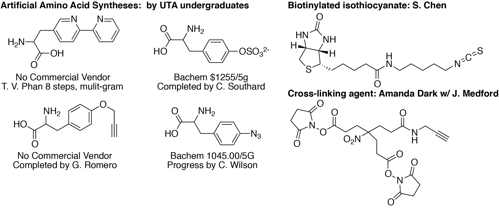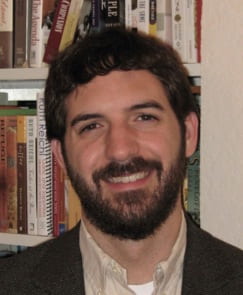A word about BIOORGANIC CHEMISTRY in our laboratory
Recent Publications
Biomimetic Catalysis: Aerobic Organocatalysis
Natural biosynthesis performs selective oxidation reactions to diversify common precursors to a number of structurally disparate molecules. Through this process, natural products occupy a large area of chemical space and these diverse molecules have equally diverse physiological effects. Unfortunately, selective oxidation reactions in the laboratory are among the most costly synthetic transformations due to combinations of poor selectivity, costly catalysts, and environmental, health, and safety concerns. Target oriented synthesis and total synthesis have historically avoided changes in oxidation state, though nature performs these transformations seamlessly. Numerous efforts exist to increase the efficiency and sustainable nature of chemical oxidation by aerobic catalysis. The specific goal of this project is to develop methods for chemoselective and stereoselective aerobic oxidations by organocatalysts.
Toward Aerobic Catalysis: The effort toward sustainable oxidative catalysis pursued by three areas of catalysis and their representation in the literature.
With a focus on bioinspired organocatalysis, we hope to expand the utility of aerobic oxidations based on nature’s well-described and versatile redox catalysts, riboflavin (green and yellow). Focusing on expanding the capability of flavin catalysts to carbon-centered oxidations and how best to provide consistent stereocontrol from tailor-made catalysts and reaction design.
Flavin mimics activate oxygen and hydrogen peroxide through the formation of the reactive 4a-hydroperoxyflavin species FlOOH. While these activated alkyl peroxides carry out electrophilic oxidations (sulfoxide, N-oxide, epoxide formations) and nucleophilic oxidations at carbon centers (Baeyer-Villiger Oxidations) in vivo, the nucleophilic nature of flavin mimics is limited outside of the enzyme. One goal is to restore this very valuable nucleophilic oxidation capability to flavin mimics through a biomimetic approach that combines mechanistic inquiry and catalyst/reaction design. Using primarily organic synthesis and a wide array of analytical techniques allows us to evaluate trends important to controlling catalyst function.
Flavin redox reactivity: canonical oxidation states of riboflavin catalysts (green), the interaction of flavin catalysts with molecular oxygen and H2O2 (yellow) in oxo-transfer reactions, and photocatalytic redox events with reduced flavin under anaerobic conditions (blue).
Catalytic Flavin Oxidations: A wealth of structural enzymatic and small molecule knowledge lead to these and other examples of useful monooxygenations.
Advances in Anti-Bacterial Discovery
Our interest in biomolecules reaches to understanding biomolecular interactions with important physiological consequences. In particular, we are interested in identifying potential enzymes, receptors, and biological structures as sites for anti-infective treatment. The first stage of this work is focused on validating specific biomolecules as tractable targets for inhibition of infective growth. Throughout this process we hope to understand the structure of the active site or binding domain and to be able to take advantage of specific intermolecular forces to design and synthesize useful inhibitors. We are currently investigating a number of biological targets that have presented themselves as potential avenues for new antibacterial design. We utilize our abilities to synthesize small molecules to probe chemical space within enzyme/receptor binding sites. In some cases we are compelled to express and purify our own targets for the development of in vitro assays. Other times, these efforts are highly collaborative with analytical, biochemical, and microbiology laboratories. These projects require a range of techniques to be employed, allowing students the flexibility to approach the study of biomolecular interactions from many perspectives and creating an environment that is dependent on developing excellent synthetic skills but also an understanding of a wide-range of biochemical techniques.
Bioactive Small Molecules
The laboratory has been involved in numerous collaborations, which expose us to broad challenges in synthesis and biological sciences. We use our synthetic knowledge to address a variety of questions about why things work in nature.
Just a few examples, primarily by UT Arlington Undergraduates.





